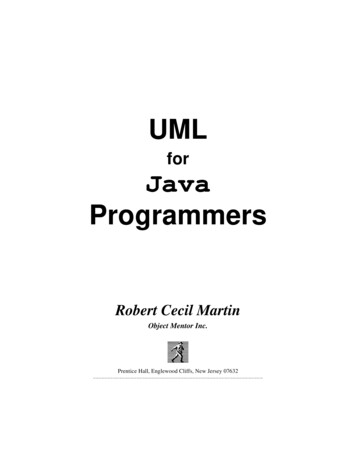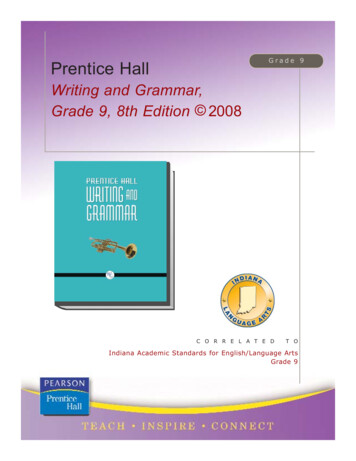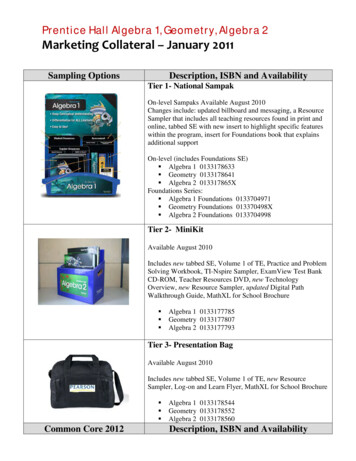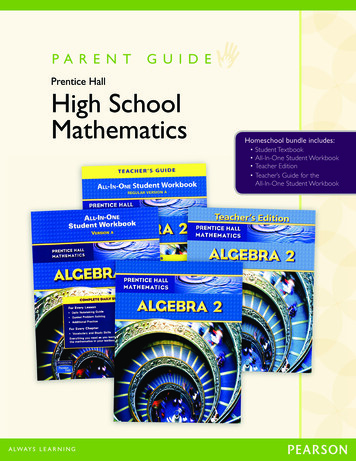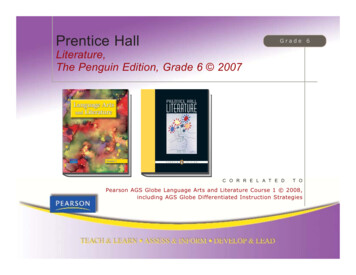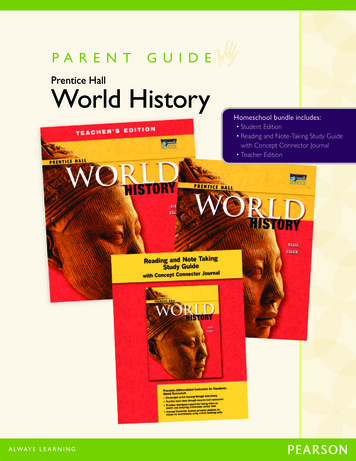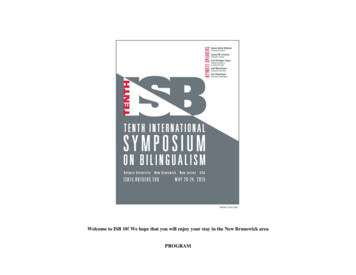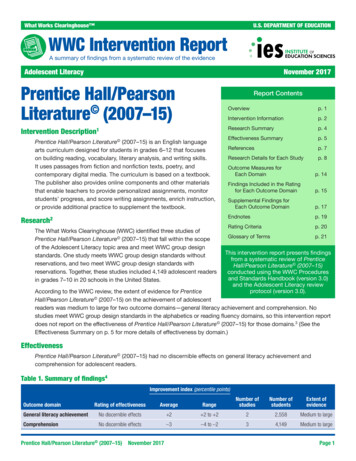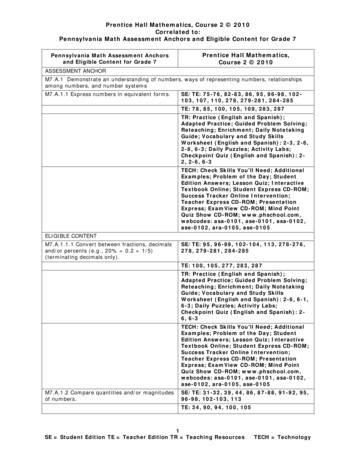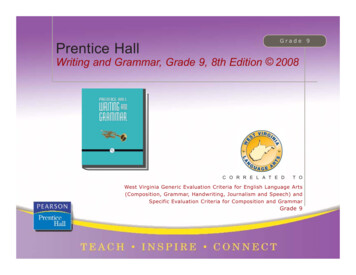
Transcription
Prentice HallGrade 9Writing and Grammar, Grade 9, 8th Edition 2008C O R R E L A T E DT OWest Virginia Generic Evaluation Criteria for English Language Arts(Composition, Grammar, Handwriting, Journalism and Speech) andSpecific Evaluation Criteria for Composition and GrammarGrade 9
INSTRUCTIONAL MATERIALS ADOPTIONPUBLISHER:SUBJECT:SPECIFIC GRADE:COURSE:TITLE:COPYRIGHT DATE:SE ISBN:TE ISBN:Pearson Prentice HallLanguage Arts9Composition and GrammarPrentice Hall Writing and Grammar, 8E200801320096330132009722GENERIC EVALUATION CRITERIAGROUP II – 2008-2014English Language Arts (Composition, Grammar, Handwriting, Journalism and Speech) K-12R-E-S-P-O-N-S-EYesNoN/ACRITERIAI. INTER-ETHNICThe instructional material meets therequirements of inter-ethnic: concepts, contentand illustrations, as set by West Virginia Boardof Education Policy (Adopted December 1970).NOTESMulti-ethnic writers are highlighted in a featured called“Writers in Action.” Students are introduced to authors fromvarious cultures and learn about their diverse backgroundsand literary contributions. This recurring feature includes:Larry Cataldo, p. 3Edgar Allan Poe, p. 19Isabel Allende, p. 49Issac Bashevis, p. 75Toni Cade Bambara, p. 82Anne McCaffrey, p. 101Edward Bulwer, p. 129Rosser Reeves, p. 157Carl Sagan, p. 177Henry David Thoreau, p. 203Gene Bryant Johnson, p. 229Zora Neale Hurston, p. 251Lawrence Chua, p. 281William Strunk, Jr., p. 293Booker T. Washington, p. 309Betsy Byers, p. 325
Models from literature are used to provide exemplars ofwriting genres for students as they begin their own papers.These literature models are by writers from a wide variety ofbackgrounds and deal with diverse themes. Titles include thefollowing:”The Shadowland of Dreams,” by Alex Haley, pp. 50–53”The Appalachian Trail,” by Bruce Eason, pp. 76–77”See Ya’ at the Subway,” by Edwina Armstrong, pp. 102–105”We Can Go Home Again,” by Nevada Barr, pp. 130–133Advertisement for Michigan Opera Theater, pp. 158”Murderous Mitch,” by Tim Padgett, pp. 204–205From Dinosaurs Rediscovered, by Don Lessem, pp. 230–231”The Indomitable Spirit of Sojourner Truth,” by WilliamKaufman, pp. 252–255”Lederer’s ‘Miracle’ Is His Well of Wit and Wisdom WithWords,” by Charles Harrington Elster, pp. 282–285Also see:Spotlight on the Humanities: exploring culturalthemes, 24, recognizing themes (A Raisin in theSun), 44, recognizing shared culture, 96See images on pp. 6, 120, 145, 172, 185, 193, 213,219, 228, 243, 252, 267, 287, 297, 308, 324, 400,405, 455, 464, 470, 484, 510, 556, 715, 790II. EQUAL OPPORTUNITYThe instructional material meets therequirements of equal opportunity: concept,content, illustration, heritage, rolescontributions, experiences and achievementsof males and females in American and othercultures, as set by West Virginia Board ofEducation Policy (Adopted May 1975).Models from literature are used to provide exemplars ofwriting genres for students as they begin their own papers.These literature models are by writers from a wide variety ofbackgrounds and deal with diverse themes. Titles include thefollowing:”The Appalachian Trail,” by Bruce Eason, pp. 76–77”See Ya’ at the Subway,” by Edwina Armstrong, pp. 102–105”We Can Go Home Again,” by Nevada Barr, pp. 130–133”The Indomitable Spirit of Sojourner Truth,” by WilliamKaufman, pp. 252–255”Lederer’s ‘Miracle’ Is His Well of Wit and Wisdom WithWords,” by Charles Harrington Elster, pp. 282–285Also see:
Spotlight on the Humanities: modern myth, 96,evaluating artistic performances, 152, evaluatingpersuasive art forms, 172, examining ideas andculture in art, 246, analyzing themes in art forms,304See images on pp. 24, 139, 148, 172, 198, 252, 273,300, 360, 363, 371, 378, 405, 484, 510, 541, 561,573, 643, 645, 675, 678, 707, 715GROUP II – 2008-2014English Language Arts (Composition, Grammar, Handwriting, Journalism and Speech) K-12(IMR Committee) Responses(Vendor/Publisher)SPECIFIC LOCATION OFCONTENT WITHIN PRODUCTI In-depth80%A Adequate80%M Minimal60%N NonexistentLess than 60%IAIn addition to alignment of Content Standards and Objectives (CSOs), materials must also clearly connect toLearning for the 21st Century which includes opportunities for students to developA.Chapter 2: A WalkThrough the WritingProcess (pp. 12-23)Chapter 30: Speaking,Listening, Viewing, andRepresenting (pp. 744–763)Chapter 32: ReadingSkills (pp. 790–809)Chapter 33: Study,Reference, and TestTaking Skills, (pp. 812–831)Chapter 34: WorkplaceSkills andCompetencies (pp. 834–845)Learning Skills Thinking and Problem-Solving Skills. Information and Communication Skills. Interpersonal and Self-Direction Skills and use these21 Century ToolsMN
Also see:Rubric for SelfAssessment/Reflectingon Your Writing, 66, 90,119, 147, 168, 192, 218,242, 270, 317Exposition: Problem–and–Solution Essay,228–229, 230–231, 232–235, 236–237, 238–240,241, 242–244B.Media and TechnologySkills: examining media'sperception of reality, 125,recognizing persuasivetechniques, 153,analyzing newscoverage, 199,evaluating movie ads,305; Reading Skills:Reading from VariedSources, 808–809;Electronic Texts:dictionary, 823,encyclopedia, 824;Standardized TestPreparation Workshop:Constructing Meaningfrom Informational Texts,832–833; Chapter 34:Workplace Skills andCompetencies, 834–845;also see: Internet:research using, 109,consumer reports on,21st Century Tools Problem-solving tools (such as spreadsheets,decision support, design tools) Communication, information processing and researchtools (such as word processing, e-mail, groupware,presentation, Web development, Internet searchtools) Personal development and productivity tools (such ase-learning, time management/calendar, collaborationtools)
197, analyzing webpages and newsgroups,199, maps on, 263, 752,759, search words, 383,745, narrowing topic with,402, library access on,816, electronicdatabases on, 818,newspapers andmagazines on, 820,electronic calendar on,842, budgeting sites on,844;
INSTRUCTIONAL MATERIALS ADOPTION: GENERAL EVALUATION CRITERIAThe general evaluation criteria apply to each grade level and are to be evaluated for each grade level unless otherwise specified. These criteriaconsist of information critical to the development of all grade levels. In reading the general evaluation criteria and subsequent specific grade levelcriteria, e.g. means “examples of” and i.e. means that “each of” those items must be addressed. Eighty percent of the combined generaland specific criteria must be met with I (In-depth) or A (Adequate) in order to be recommended.GROUP II – 2008-2014English Language Arts (Composition, Grammar, Handwriting, Journalism and Speech) K-12(IMR Committee) Responses(Vendor/Publisher)SPECIFIC LOCATION OFCONTENT WITHIN PRODUCTI In-depth80%A Adequate80%M Minimal60%N NonexistentLess than 60%IAFor student mastery of content standards and objectives, the instructional materials will provide students with the opportunity toA.A wide range oftechnologyresourcessupport everyaspect of theprogram. Theseinclude thefollowing:InteractiveTextbook(availableonline atwww.pearsonsuccessnet.com or on CDROM) providesthe samecontent as thetextbook and inaddition includesMultimedia1.Offer appropriate multimedia (e.g., software, audio, visual,internet access) materials.MN
the following: In addition, thePrentice HallOnline EssayScorerprovidesinstant scoringand feedbackfor Topic Bankassignments ineach Writingchapter andcan be foundatpearsonsuccessnet.com. InteractiveWriting andGrammarExerciseswebcodesthroughout thestudent editionallow studentsto quicklyaccess onlinegrammarexercises,reviews,writing tools,and tutorials DiagnosticTests andScoringRubricsOthermultimediaresourcesinclude thefollowing: TeacherExpress CD-
ROM whichcontainslessonplanningsoftware,searchableand printableresources, andintegratedteachingcalendar forlessonorganization ExamviewTest BankCD-ROMcreatescustomizabletests,worksheetsand studyguides forprint, LANbased, andInternet-basedtests Writers atWork DVDwhich includesin-depthinterviews withauthors whoexplain howtheyincorporate thewriting processinto their dailylivesSee nextstandard fordetailedexplanation ofInternet
components ofthis program.InteractiveTextbook(availableonline atwww.pearsonsuccessnet.com or on CDROM) providesthe samecontent as thetextbook and inaddition includesthe following: InteractiveWriting andGrammarExerciseswebcodesthroughout thestudent editionallow studentsto quicklyaccess onlinegrammarexercises,reviews,writing tools,and tutorials In addition, thePrentice HallOnline EssayScorerprovidesinstant scoringand feedbackfor Topic Bankassignments ineach Writingchapter andcan be found2.Provide a website which provides links to relevant sites as wellas lesson plans, student activities and parent resources.
atpearsonsuccessnet.com. DiagnosticTests andScoringRubricsIn the Teacher’sEdition, links tothe InteractiveTextbook canbe foundthroughout thetext, but forexamples,please see pp.2b, 12b, and28b. Links canalso be found inthe studentedition on pages57, 116, and469.For examples ofonline support,seehttp://phschool.com/atschool/writing grammar/webcodes/programpage.html andfollowing thelinks for eachlevel of theprogram. In addition, thePrentice HallOnline EssayScorer
providesinstant scoringand feedbackfor Topic Bankassignments ineach Writingchapter andcan be foundatpearsonsuccessnet.com asreferenced inthe Teacher’sEdition text onpp. 90, 119,and 147Skills for usingandunderstandingtechnology aredeveloped inMedia andTechnologySkills pages, seepp. 9, 25, 45, 71,97, 125, 153,173, 199, 225,247, 277, 305,321, and 335A wide range oftechnologyresourcessupport everyaspect of theprogram. Theseinclude ate technology into the curriculum.
online atwww.pearsonsuccessnet.com or on or onCD-ROM)provides thesame content asthe textbook andin additionincludes thefollowing: In addition, thePrentice HallOnline EssayScorerprovidesinstant scoringand feedbackfor Topic Bankassignments ineach Writingchapter andcan be foundatpearsonsuccessnet.com. InteractiveWriting andGrammarExerciseswebcodesthroughout thestudent editionallow studentsto quicklyaccess onlinegrammarexercises,reviews,writing tools,and tutorials Diagnostic
Tests andScoringRubricsOthermultimediaresourcesinclude thefollowing: TeacherExpress CDROM whichcontainslessonplanningsoftware,searchableand printableresources, andintegratedteachingcalendar forlessonorganization ExamviewTest BankCD-ROMcreatescustomizabletests,worksheetsand studyguides forprint, LANbased, andInternet-basedtests Writers atWork DVDwhich includesin-depthinterviews withauthors who
explain howtheyincorporate thewriting processinto their dailylivesSee nextstandard fordetailedexplanation ofInternetcomponents ofthis program.B.The programemphasizesstudentawareness of avariety oflearningstrategies. InChapter 32:Reading Skillsthe first sectionprovidesinstruction in theuse of graphicorganizers (pp.796–797).In addition,every writinglesson in theprogramintroduces avariety ofgraphicorganizers toreinforce thestages of theScientifically-Based Research Strategies1.Provide explicit instructional strategies to present varied teachingmodels including but not limited to: webbing, mapping, Venndiagrams and inverted pyramids.
writing process.For examplesplease seeChapter 2: AWalk Throughthe WritingProcess pages15, 16, and 17,as well asexamples fromother writingchapters such asthose found onpages 57, 160,and 234.The Writer inYou, 2–7; AWalk Throughthe WritingProcess, 12–23;Narration:Autobiography,48–70;Narration: ShortStory: arison–and–ContrastEssay, 176–198;Exposition:Cause–and–Effect Essay,202–224;Exposition:2.Promote writing skills and study techniques.
Problem–and–Solution Essay,228–246;Research Paper,250–276;Response toLiterature, 280–304; Writing forAssessment,308–320;WorkplaceWriting, 324–334; Pleasenote: In addition, thePrentice HallOnline EssayScorerprovidesinstant scoringand feedbackfor Topic Bankassignments ineach Writingchapter andcan be foundatpearsonsuccessnet.com.Also see,Chapter 33:Study,Reference, andTest-TakingSkills, pp. 812–831Varied teachingmodels anddifferentiatedinstruction canbe foundintegrated3.Present varied teaching models with emphasis on differentiatedinstruction in content, process and product.
throughout thetext.The Time andResourceManager thatintroduces everychapter of theprogram (seepp. 48a-b, 280ab, and 524a-b)includes anoverview of andpage list for thefollowing: In-depthLesson Plan AcceleratedLesson Plan Options forAdaptingLesson Plans IntegratedSkillsCoverage MeetingIndividualNeeds BlockScheduling AssessmentSupportAlso see theCustomizefor differentiatedinstructionteaching notesintegrated atpoint of usethroughout the
teacher’s edition.Examplesinclude thefollowing: Customize forESL Students(p. 111) Customize forLogical/MathematicalLearners (p.261) Customize forIntrapersonalLearners (p.333) Customize forLessAdvancedStudents (p.576) Customize forMoreAdvancedStudents (p.586) Customize forVisual/ SpatialLearners (p.662)(Vendor/Publisher)SPECIFIC LOCATION OFCONTENT WITHIN PRODUCT(IMR Committee) ResponsesI In-depth80%A Adequate80%M Minimal60%N NonexistentLess than 60%IAMN
C.Questioningmodels are taughtto students in anumber ofsections of theprogram.Critical Thinking11.2Chapter 32:Reading Skillsincludes sectionson Using theSQ4R Method(pp. 793–794),ReadingNonfictionCritically (pp.798–803), andReadingActively (p. 804).In addition, theteacher’s editionincludes a stepby-stepdevelopmentalteaching guide forevery chapter thatincludesnotes/guides oneach of theBloom’sTaxonomycompetencies asfollows: Knowledge:Activating PriorKnowledge (seep. 75) Comprehension: TeachingFrom the ModelEmphasize questioning models to promote higher order thinkingskills based on Bloom’s Taxonomy.
(see p. 76) Application:guide for stepsof the writingprocess asstudents write(see p. 83) Analysis:Respondingto notes (seep. 79) Synthesis:IntegratingRepresentingSkills (see p.84) Evaluation:Assess guidewith notes (seep. 90)Studentgeneratedresponses areintegratedthroughout theprogram. Allsection lessonsbegin with anActivating PriorKnowledgeactivity (see pp.281 and 346).The Step-by-Stepteaching guidenot only baseslessons onstudentgeneratedresponses, butalso suggestscooperativelearning activitiessuch as those2.Promote student-generated responses.
found on pp. 388and 581.In addition, allsteps of thewriting process,include peerreview andshared responseactivities such asthose found onpp. 190 and 267.Students alsogeneratereflectiveresponses usingthe Reflecting onYour Writing andRubric for SelfAssessmentactivities at theend of every oneof the majorwriting activitiessuch as thosefound on pp. 218and 242.D.Life skills areintegratedthroughout theprogram (seetechnology andwriting referencesabove), but thereare two keychapters thatexemplify thisemphasis. Thefirst is ChapterLife Skills1.address life skills (e.g., reading road maps, using reference tools,researching, reading a newspaper, using want ads, completing anapplication, applying the interview process and goal setting).
34: WorkplaceSkills andCompetencies(pp. 834–845)includes thefollowingsections: Working WithPeople LearningTeamwork Moving TowardYour Goals SolvingProblems andThinkingCreatively Managing Time ManagingMoney Applying MathSkills ApplyingComputer SkillsIn addition,Chapter 30:Speaking,Listening,Viewing, andRepresenting(pp. 744–763)includes thefollowingsections: Speaking in aGroupDiscussion Giving aSpeech Using Critical
Listening InterpretingMaps andGraphs ViewingInformationMedia Critically Creating VisualRepresentationsHabits of mindskills andmetacognitiveapproaches areintegratedthroughout theprogram, butthere are two keychapters thatexemplify thisemphasis. Thefirst is Chapter32: ReadingSkills (pp. 790–809) includes thefollowingsections: ReadingMethods andTools ReadingNonfictionCritically Reading fromVaried SourcesIn addition,Chapter 33:Study,Reference, andTest-Taking2.Address habits of mind activities (e.g., literacy skills, interpersonalcommunications, problem solving and self-directional skills).
Skills (pp. 812–831) includes thefollowingsections: Basic StudySkills ReferenceSkills Test-TakingSkillsIn addition, thevaried teachingmodelsmentioned abovealso serve toengage studentsin a variety oflearningmodalities andhabits of thinking.For example, theCustomize for differentiatedinstructionteaching notesinclude thefollowing: Customize forESL Students(p. 111) Customize forLogical/MathematicalLearners (p.261) Customize forIntrapersonalLearners (p.333)
Customize forLess AdvancedStudents (p.576) Customize forMore AdvancedStudents (p.586) Customize forVisual/ SpatialLearners (p.662)E.Opportunities forstudents to workin a wide varietyof cooperativegroups as well asindependently areintegrated intoevery lesson.The Step-by-Stepteaching guidesuggestscooperativelearning activitiessuch as thosefound on pp. 388and 581.See examples inthe Teacher’sEdition: pp. 6, 14,40, 44, 66, 88,94, 102, 107,145, 235, 258,406, 493, 559,757)In addition, allsteps of thewriting process,Classroom Management1.Include opportunities for large group, small group and independentlearning.
include peerreview andshared responseactivities such asthose found onpp. 190 and 267.Students alsogeneratereflectiveresponses usingthe Reflecting onYour Writing andRubric for SelfAssessmentactivities at theend of every oneof the majorwriting activitiessuch as thosefound on pp. 218and 242.The Customizefor differentiatedinstruction offerbothindividualized andgroup learningactivities such asthose found onthe followingpages: Customize forESL Students(p. 111) Customize forIntrapersonalLearners (p.333)In addition, the
skills required forgroup work arecovered in thefollowingchapters:Chapter 34:Workplace SkillsandCompetencies(pp. 834–845)includes thefollowingsections: Working WithPeople LearningTeamwork Moving TowardYour Goals SolvingProblems andThinkingCreativelyChapter 30:Speaking,Listening,Viewing, andRepresenting(pp. 744–763)includes thefollowingsections: Speaking in aGroupDiscussion Using CriticalListeningFor professional2.Provide classroom management suggestions.
support guidanceand opportunities,see theResources forVaryingInstruction andProfessionalDevelopmentSupportreferenced in theTime andResourceManager pagesbefore eachchapter of theteacher’s edition(examples on pp.156a-b and 448ab).Other classroommanagementsuggestions listedin the Time andResourceManager include: In-depthLesson Plan AcceleratedLesson Plan Options forAdaptingLesson Plans IntegratedSkillsCoverage MeetingIndividualNeeds BlockScheduling AssessmentSupport
These lessonplans and theStep-by-StepTeaching Guidein the teacher’sedition aresupported byongoingassessmentnotes such asthose found onpp. 452 and 498which support thestages of thesuggestedlessons.The Time andResourceManager (see pp.420a-b and 550ab) references theCustomize for differentiatedinstructionteaching notesand assessmentopportunities asfollows: MeetingIndividualNeeds AssessmentSupportThe Customizefor differentiatedinstructionteaching notesthemselves are3.Provide suggestions for differentiated instruction (e.g., practiceactivities, learning stations, assessment, lesson plans).
integrated atpoint of usethroughout theteacher’s edition.Examples includethe following: Customize forESL Students(p. 285) Customize forLess AdvancedStudents (p.283) Customize forGifted /TalentedStudents (p.301) Customize forBodily/Kinesthetic Learners (p.83)OngoingAssessmentsupportreferences followthe developmentof each lessonthroughPrerequisiteSkills, Monitorand Reinforceand AssessMastery (see pp.451, 452, and482).Students alsohave a variety ofself-assessmentopportunities
using theReflecting onYour Writing andRubric for SelfAssessmentactivities at theend of every oneof the majorwriting activitiessuch as thosefound on pp. 66and 270.F.A variety ofmodels andassignments giveteachers andstudents a wealthof opportunities toexplore writing,language, andreading skillsusing differentstyles andmultipleintelligences.Every writingchapter beginswith a Modelfrom Literature(see pp. 50–53and 158), andthen also includesa Student Workin Progress (seepp. 165, 166, and169).ConnectedAssignmentsInstructional Materials2.Address varied learning styles and multiple intelligences of studentsby including models.
(pp. 94–95 and151) givestudents theopportunity toconnect writingactivities to othergenres ofexpression.Spotlight on theHumanitiesactivities such asthose found onpp. 152 and 224connect thewritten word toother artisticforms. Media andTechnologySkills givestudents theopportunity tosee how avariety of mediaalso reflect thethinking andlearning skillsthey aredeveloping inother areas ofthe program(see pp. 9, 25,45, 71, 97, 125,153, 173, 199,225, 247, 277,305, 321, and335).The Customizefor differentiated
instructionteaching notesinclude optionsfor supportingmultipleintelligences asseen in thefollowingexamples: Customize forLogical/MathematicalLearners (p.261) Customize forIntrapersonalLearners (p.333) Customize forVerbal/LinguisticLearners (p.311) Customize forVisual/ SpatialLearners (p.662)The structure ofthe book iscentered aroundstudents gettingdirectly involvedin all skills taught.For example, thefirst half of thebook uses aseries of writingassignments aslessons. Studentsare expected todevelop skills as3.Provide extensive and varied opportunities to practice skills.
they create theirown pieces ofwriting. See thefollowing chaptersas ay, 176–195;Exposition:Cause–and–Effect n Essay,228–244The next sectionof the book onGrammar, Usage,and Mechanics,provides studentswith practice skillsthroughout aswell, includingexercises afterkey concepts(see pp. 342 and343), sectionreview exercises(see pp. 345 and373), as well asStandardizedTest PreparationWorkshops (seepp. 376–377 and446–447).A variety ofextensionactivities provideadditional
practice andapplication ofskills as follows: ConnectedAssignments(pp. 94–95 and151) givestudents theopportunity toconnect writingactivities toother genres ofexpression. Spotlight onthe Humanitiesactivities suchas those foundon pp. 152 and224 connect thewritten word toother artisticforms. Media andTechnologySkills givestudents theopportunity tosee how avariety of mediaalso reflect thethinking andlearning skillsthey aredeveloping inother areas ofthe program(see pp. 9, 25,45, 71, 97, 125,153, 173, 199,225, 247, 277,305, 321, and335).
Interventionstrategies can befound inResources forVaryingInstruction andProfessionalDevelopmentSupportreferenced in theTime andResourceManager pagesbefore eachchapter of theteacher’s edition(examples on pp.156a-b and 448ab).The Time andResourceManager (see pp.420a-b and 550ab) references theCustomize for differentiatedinstructionteaching notesand assessmentopportunities asfollows: MeetingIndividualNeeds AssessmentSupportThe Customizefor 4.Provide intervention, practice and enrichment materials.
differentiatedinstructionteaching notesthemselves areintegrated atpoint of usethroughout theteacher’s edition.Examples includethe following: Customize forESL Students(p. 285) Customize forLess AdvancedStudents (p.283) Customize forGifted /TalentedStudents (p.301)Every writingchapter beginswith a Modelfrom Literature(see pp. 50–53and 158), andthen also includesa Student Workin Progress (seepp. 165, 166, and169).The writingchapters cover allthe major genresof writing asfollows:A Walk Through5.Provide exemplars of narrative, descriptive, informative andpersuasive writing types.
the WritingProcess, 12–23;Narration:Autobiography,48–68; Narration:Short Story: 74–93; Description,100–121;Persuasion, 128–150; rison–and–ContrastEssay, 176–195;Exposition:Cause–and–Effect n Essay,228–244;Research Paper,250–274;Response toLiterature, 280–302; Writing forAssessment,308–318;WorkplaceWriting, 324–331(Vendor/Publisher)SPECIFIC LOCATION OFCONTENT WITHIN PRODUCT(IMR Committee) ResponsesI In-depth80%A Adequate80%M Minimal60%N NonexistentLess than 60%IAMN
Every unitincludes aStudent Work inProgress (seepp. 165, 166, and169).6.Provide exemplars of editing/revision for writing.In addition, allsteps of thewriting process,include peerreview andshared responseactivities such asthose found onpp. 190 and 267.Students alsogeneratereflectiveresponses usingthe Reflecting onYour Writing andRubric for SelfAssessmentactivities at theend of every oneof the majorwriting activitiessuch as thosefound on pp. 218and 242.This standard isaddressed by theprogram as awhole, whichfunctions as aninteractiveHandbook of theEnglishLanguage. Forexample, in Part7.include a Handbook of English Language within the text for writingsupport (grades 5-12) and a supplemental handbook for gradesK-4.
2 of the program,entitledGrammar,Usage, andMechanics,chapters include(but are notlimited to) thefollowing: Nouns andPronouns (pp.340–359) Verbs (pp.360–377) BasicSentenceParts (pp. 420–447) MiscellaneousProblems inUsage (pp.614–635)In addition, pagesat the end of theprogram, startingon p. 880, includethe followingreferenceresources forstudents: Citing Sourcesand PreparingManuscript CommonlyOverusedWords CommonlyMisspelledWords Abbreviations
Guide ProofreadingSymbolsBoth the writingchapters and thelanguage/grammarchapters arestructureddevelopmentallyand thus can beeasily presentedin both block andmulti-dayinstructionalplans.The first place forinstructors tobegin planning isin the Time andResourceManager thatintroduces everychapter of theprogram (see pp.48a-b, 280a-b,and 524a-b) andincludes anoverview of andpage list for thefollowing: In-depthLesson Plan AcceleratedLesson Plan Options forAdaptingLesson Plans8.Continue skill or strategy instruction across several instructionalsessions to expand the applicability and utility of the skill or strategy.
IntegratedSkillsCoverage MeetingIndividualNeeds BlockScheduling AssessmentSupportIn addition,Teacher ExpressCD-ROM whichcontains lessonplanningsoftware,searchable andprintableresources, andintegratedteaching calendarfor lessonorganization canbe used to save,edit, personalize,and schedulelesson plans.As noted above,the teacher’sedition includes astep-by-stepdevelopmentalteaching guide forevery chapter thatincludesnotes/guides oneach of theBloom’sTaxonomycompetenciesincluding prior9.Connect previously taught skills and strategies with new contentand text.
knowledge: Knowledge:Activating PriorKnowledge (seep. 75)OngoingAssessmentsupportreferences followthe developmentof each lessonthroughPrerequisiteSkills, Monitorand Reinforceand AssessMastery (see pp.451, 452, and482) so thatteachers cantrack the flow ofpreviously taughtskills andstrategies.In addition, eachof the Grammar,Usage, andMechanicschapters beginswith a DiagnosticTest, the resultsof which guidethe teacherthrough thesections of thechapter (see pp.341, 361, and379) throughOngoingAssessmentcharts in the
teacher’s edition(see teacher’swrap below thepages listedabove).Both the writingchapters and thelanguage/grammarchapters arestructureddevelopmentally.Writing chaptersfocus on bothgeneral andspecific strategiesin severalcategories thatrepeat: Prewriting (seep. 134–138) Drafting (see p.139–140) Revising (seep. 141–145) Editing (see p.146) Publishing andPresenting(see p. 147)Within theserepeated writingprocessstrategies, aremore specificsub-categoriesthat also repeat inevery lesson,providing10.Cumulatively build a repertoire of multiple strategies that areintroduced, applied and integrated throughout the course of study.
students withboth structureand variety intheir approach tomastering theirown writing.These strategiesinclude, but arenot limited to thefollowing: Choosing YourTopic(see p.180) NarrowingYour Topic(see p. 182) GatheringDetails orEvidence (seep. 183) Shaping YourWriting (see p.184) RevisingOverallStructure (seep. 186)A range oflearningstrategies arealso taught andsummarized inseveral chaptersthat allowteachers toisolate specificapproaches tolearning and helpstudents integratethem in otherareas of theprogram and their
lives. Thesechapters include: Chapter 2: AWalk Throughthe Writing(pp. 12–23) Chapter 30:Speaking,Listening,Viewing, andRepresenting(pp. 744–763) Chapter 32:Reading Skills(pp. 790–811). Chapter 33:Study,Reference, andTest-TakingSkills (pp. 812–831) Chapter 34:WorkplaceSkills andCompetencies(pp. 834–845)G.A wide range ofprint andtechnologyresources supportassessment inevery aspect ofthe program.These include thefollowing:In the studentedition:Assessment1.Provide assessment formats commensurate with WV assessmentprograms (e.g., WESTEST, NAEP, State Writing Assessment,informal assessments, PLAN, EXPLORE, ACT and SAT).
StandardizedTestPreparationWorkshops(see pp. 306–307, 336–337,724–725) TestPreparationHandbook:Preparing forthe New SATand ACT (seepp. 848–879) Rubric forSelfAssessment(see pp. 218and 242) DiagnosticTest (see pp.341 and 525) Section,Chapter, &CumulativeReview (seepp. 517, 518–519, and 522–523)In the teacheredition: OngoingAssessmentsupportreferencesfollow thedevelopment ofeach lessonthroughPrerequisiteSkills, Monitorand Reinforce
and AssessMastery (seepp. 451, 452,and 482) Test-TakingTips (see pp.398 and 520)In technology andprint resources: In addition, thePrentice HallOnline EssayScorerprovides instantscoring andfeedback forTopic Bankassignments ineach Writingchapter and canbe found atpearsonsuccessnet.com. DiagnosticTests andScoringRubrics (alsoin InteractiveTextbook) TeacherExpress CDROM whichcontains theExamview TestBank C
Prentice Hall Writing and Grammar, Grade 9, 8th Edition 2008 . These literature models are by writers from a wide variety of . Textbook (available online at www.pearson successnet.co m or on CD-ROM) provides the same content as the textbook and in addition includes 1. Off
